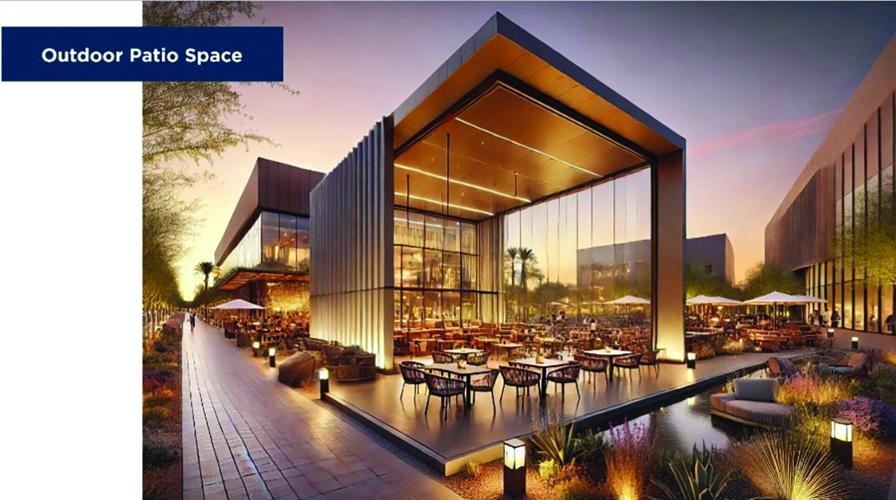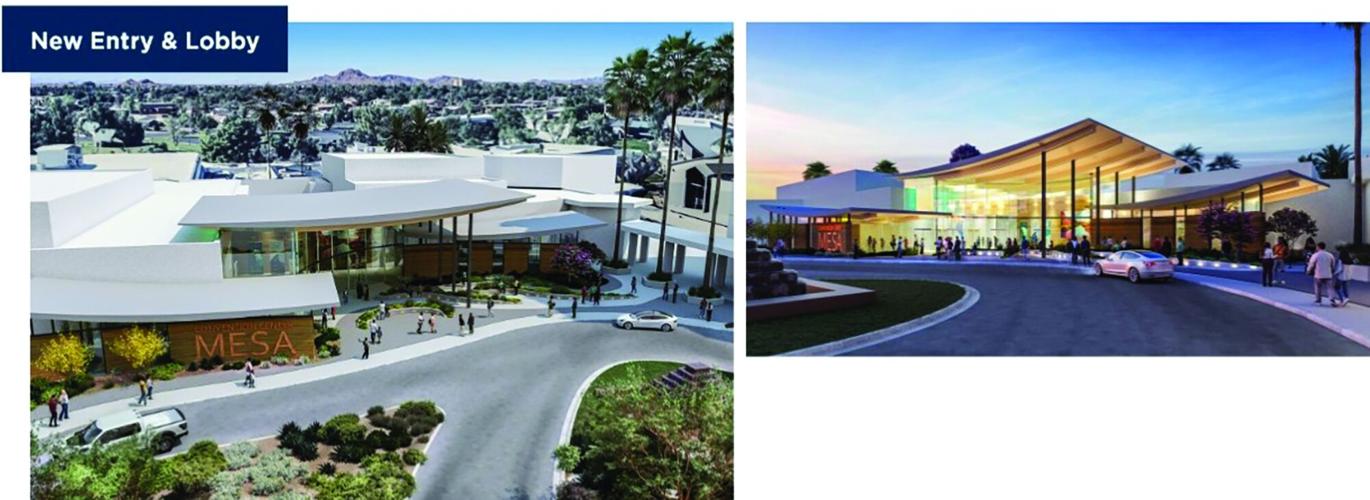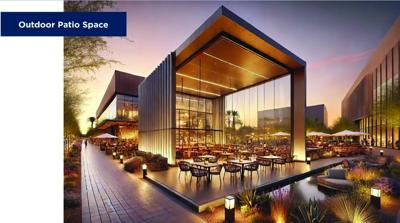Mesa is considering a facelift of its decades-old convention center and amphitheater in an effort to spur more economic activity downtown and to fill rooms at the underperforming Delta Hotels by Marriott on the same campus.
Without the upgrades, the city faces losing out on higher-quality events and shows in a crowded competitive field of similar sized but modern venues in the Valley, according to a consultant from Conventions, Sports & Leisure International.
CSL produced a 190-page draft study with recommended fixes, such as a new entryway and lobby area and overhead shade and mister stations for the adjoining open-air amphitheater.
“We got to move forward or maybe if we don’t believe in having this kind of space here, then piece it off for other kinds of development,” said Councilwoman Jenn Duff, who represents the area.
“I think it adds to the synergy that we need for the downtown and economic development and building a business and workforce-related, especially in the technology fields. So I believe in it but doing nothing is not a good strategy.”
CSL analyzed 50 different theaters and convention facilities around the Valley and 20 other facilities it considered best-practice facilities around the country.
It also interviewed over 65 different event planners, conference planners and concert promoters as to the types of event space and size of event space they need in order to bring their business to Mesa, consultant Tyler Othen said at last week’s council study session.
They were also asked what their business look like “in terms of attendance, in terms of room nights, in terms of the per-day spending their attendees generate while they’re in the destination,” Othen said.
According to the planners, the convention center, built in the 1970s-1980s, was dated. They also said the size of the adjoining 274-room hotel and its 9,000-square-foot ballroom restricted users and center is disconnected from downtown.
“There is that 15-minute disconnect, and there’s not really a reason to make that journey from the building to downtown,” Othen said. “So how do we better connect to them and get them more familiar?”
There were, however, benefits that stood out for the planners – such as space flexibility, the ability to host events outdoors and the layout of the campus that allowed people to walk from one meeting room to another, he said.
He said that although the recent joint effort by the hotel, the convention center and Visit Mesa have upped the number of conferences in the city to 26 last year from 15 in 2019, “that market share is not guaranteed.”
“What we’re seeing in the Valley certainly is more facilities,” Othen said. “We’re seeing a crowded field of competitors that are similar size to us and we’re seeing much higher-quality products” such as Talking Stick Resort and JW Marriott Phoenix Desert Ridge Resort & Spa, which have higher-quality and more modern amenities.
Othen said that a new crop of event planners comprising Gen Z and millennials have a new preference for what they want in a space.
“They’re not just looking for the event space, the square footage to accommodate them,” he said. “They’re looking for experiences. They’re looking for something that’s truly unique, authentic every time they choose a new host site. So with Mesa Convention Center and some things that got them excited were the opportunity for developing outdoor event space.”
According to Othen, the event planners saw a need for bigger lobbies, which are in use more than ever for general sessions and for programming.
“They don’t just want to go right into a building and go into the programmed rooms in the meeting spaces and ballrooms,” he said. “They want to be able to use every square foot, every square foot in the footprint as part of their events for networking sessions, for more dynamic programming.
“Immersive experiences, this is something we’re seeing in the entertainment and sports space with the use of LED and projection mapping lighting.”
Planners also are looking at outdoor event patios and terraces to host not just side actives like networking sessions but for general sessions and food functions, he said.
The study proposed two scenarios to guide the next five years of the city’s investment in the conference center.
The first was an all-out approach that included developing 10,000 square feet of outdoor patio space, expanding and updating the lobby, improving the connection to downtown, updating the finishes in the ballrooms and meeting rooms and enhancing the Wi-Fi. The estimated cost for that scenario is $30.3 million.
The less-intensive option called for updating the lobby, improving Wi-Fi, updating the finish and using a fabric tent structure to create a covered pavilion at an estimated cost of $18.3 million.
CSL also provided two options for the amphitheater’s upgrades.
With more people attending concerts, the Mesa Amphitheatre is competing for artists and dollars against recently improved venues, according to Othen.
“These are very modern venues that provide premium experiences to their artists and provide premium experiences to their attendees” he said, adding that Mesa’s amphitheater was lacking that due to the age of the structure, which opened in 1978.
He noted an amphitheater in West Palm Beach, Florida, has a cocktail lounge, outdoor patio and pool for performers.
“This is something where you’re building an experience for the artists because nowadays in the industry everybody’s on tour to make money and word of mouth spreads pretty fast from artist to artist about the premium experience in a venue,” he said. “We are seeing venues start to lose business as some of their competitors are enhancing their hospitality amenities.
“So we want to create a buzz among the artists who play here. At the same time we also want to improve the experience for fans.”
CSL’s first option included overhead shading and mister stations throughout the amphitheater, a new permanent beer stand, VIP seating area, a green room and hospitality space, enhanced rigging capacity for sound and lighting and installation of technology like projection mapping. The cost is estimated at $17.4 million.
If the city wanted to do less, CSL recommended the green room and hospitality space, the rigging and overhead shading and misters at a cost of $9.8 million.
“The big why behind these projects, obviously it would be a huge helper to the revitalization of downtown,” Othen said. “These are some cool ideas that would look nice, probably get some national press if you talk about some of these immersive experience concepts. … We heard straight from the consumers that this is the type of product they’re looking for.”

A new entryway and lobby are envisioned for the Mesa Convention Center.
Randy McGrane of Ensemble Investments, owner and operator of the 12-story Delta Hotels, spoke in favor of the proposed improvements. Ensemble purchased the hotel in 2016 and put in $15 million in upgrades, according to McGrane.
“We are embedded in the middle of essentially a Civic Center and a convention center,” McGrane said. “We can never succeed if the convention center doesn’t succeed.
“We have invested a lot of money. The hotel is not performing. We have worked very hard. We’ve seen the amazing developments in downtown Mesa. Everything I imagined would happen, I’ve seen it happen (but) it’s not translating to room nights and revenue. We’re not succeeding as a hotel and we need to address that in order to continue to be a vibrant part of this downtown community.”
McGrane said the hotel also planned to do improvements, including adding a significant food and beverage outlet, updating the ballroom and breakout spaces, creating a new outdoor gathering and event space and improving pedestrian connectivity that would link the hotel, convention center, amphitheater, downtown and the planned Culdesac residential project. It also was in active negotiations with Marriott to approve an upbrand to maybe a full-service Marriott, he said.
“We will always be a drag on the success of the convention center if we’re not providing the hotel amenities that are required to attract the kind of groups we need,” he said.
Vice Mayor Scott Somers said that the proposal was more of a vision at this point as officials haven’t worked through any details yet of how the city was going to accomplish the task.
“My district’s probably as far away from downtown as you can get because I’m in southeast Mesa,” Somers said, asking what kind of concerts and events the city can expect to see if it made the investment.
“Right now it’s cat shows and knife shows,” he said. “Sell me in southeast Mesa; why should we make the investment in this? What are we going to get?”
Othen responded that although the city’s calendar is busy with cat and reptile shows there’ll be gaps two years out to bring in more conventions.
“The business is out there,” he said. “These high-spenders from very high, affluent industries are willing to come here if we make improvements. They’re not coming to a dated building in the ‘70s, ‘80s that feel like a civic center today.”
The city’s investment would yield significant economic impact, he said, pointing to a 20-year net present value of $78.5 million in direct spending.
Other than finding the funding mechanism for the improvements, Somers said, “We need to bring into more focus the conversation of what the niche is, what the business model is, what the return on investment is, what we are truly trying to accomplish here so people have a very clear idea.”
“We’re not trying to be Phoenix, we’re not trying to be San Diego,” he said.
Andrea Moore, Parks and Recreation director, responded that the city is trying to do bigger and better events.
“The convention center right now is full,” she said. “We have many months that we have to shut down bookings because we have so many. We’re trying to elevate that to a higher-level of revenue per event. And to do that this niche, the high-technology niche would double those types of conventions, trade shows, business meetings that come in above where we are currently at.”
Councilwoman Julie Spilsbury said she’s been to cities much smaller than Mesa’s with incredible convention centers and wondered “why we don’t have this.”
“I think it’s something that our city’s ready for to bring this to a new level,” she said, asking if bonds would be used.
Councilman Rich Adams also asked who and how the improvements would be funded.
“Personally, I’d love to see a funding mechanism where visitors and users pay for the greater share of it,” Adams said. “What I would struggle with a bit is how to sell to the average Mesa resident who maybe isn’t a concert-goer or doesn’t particularly care about conventions and meetings. How do I sell to the average Mesa taxpayer why they should pay for it?”
City Manager Chris Brady said the purpose of the presentation was to get council’s consensus to move forward and then return in the future with an financing plan
He also said that convention centers by themselves are not significant revenue generators and that Mesa spends half a million dollars yearly to cover the convention’s shortfalls and operations, which occurs pretty much in every city.
“So why do cities do convention centers?” Brady said. “It’s for everything you all talked about. It’s for that experience that brought you to those communities. You stayed in their hotels. You went and enjoyed their downtown and their amenities, their restaurants and spent money there.
Mayor Mark Freeman said that people will criticize the city for spending money on the convention center, which the council members will need to weigh in once they get into the numbers. “I’m all about investing in Mesa, helping our downtown businesses and other businesses grow,” he said. “I think it’s time to move forward on that.”




